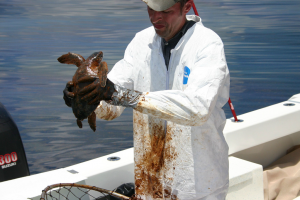Scientists suggest evaluating ecosystem services to better understand Gulf oil spill impacts
By Alisha Renfro, Ph.D., National Wildlife Federation
On April 20, 2010, the Deepwater Horizon platform exploded, resulting in a spill of 200 million gallons of crude oil into the Gulf of Mexico (GoM). Under the U.S. Oil Pollution Act of 1990, this oil spill triggered the Natural Resource Damage Assessment (NRDA) process, which determines the extent and severity of the injury to natural resources. The complexity of the GoM ecosystem—coupled with the scale of the event—poses a serious challenge to NRDA, which historically has been applied to smaller, shallow-water events.

Dr. Brian Stacy, NOAA veterinarian, prepares to clean an oiled Kemp’s Ridley turtle. Credit: NOAA and Georgia Department of Natural Resources.
In recognition of these challenges, members of the U.S. Congress requested a study by the National Academy of Sciences (NAS) to assess oil spill’s impacts on Gulf natural resources and to provide advice to federal agencies during preparation of the NRDA.
Recently, the 16-member committee released an interim report on their findings, “Approaches for Ecosystem Services Valuation for the Gulf of Mexico After the Deepwater Horizon Oil Spill,” and a final report will be delivered in spring 2013. The interim report focuses on three key questions:
- What are the methods available for identifying and quantifying ecosystem services?
- What information and methods are available that can be used to approximate baselines for determining the oil spill’s effects on ecosystem services?
- Which evaluation methods are most appropriate for measuring the recovery of ecosystem services over time?
It is important to understand the spatial and temporally variability, complex linkages, and interactions between various components of the GoM system to fully quantify the impacts of the oil spill. Past events that prompted the NRDA process have used the Habitat Equivalency Analysis (HEA) and the Resource Equivalency Analysis (REA), which measure an event’s effect on the number of acres damaged in terms of how many acres of habitat need to be restored, and measures injury to specific organisms in terms of how many numbers of a particular wildlife need to be reintroduced. However, the GoM has complex, long time-scale interactions and using these methods requires they be broadened to include an ecosystem services approach that would better consider the benefits to the public from the affected area or resource.
The NRDA process is currently underway with data being gathered to assess the damage caused by the BP oil disaster on the vital GoM ecosystem. The long-term effects and impacts of this event may not be fully understood for years, but the effort is underway to estimate the value of these damages so that appropriate restoration efforts can be developed and implemented. The NAS’s interim report concludes that an ecosystem services approach would complement the current NRDA processes. Understanding the ecosystem services value and usefulness of a resource to the public would improve the understanding of the oil spill’s impacts and increase the options for achieving meaningful efforts for restoration of the critical services provided by the Gulf of Mexico ecosystem.